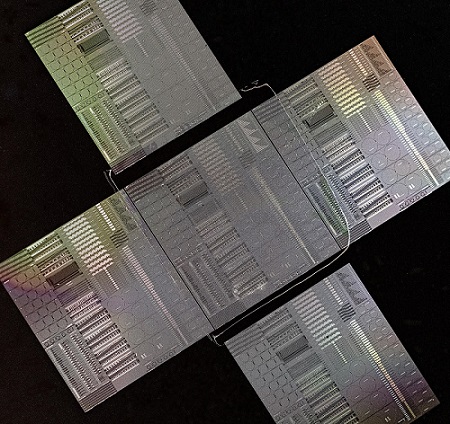A collaboration between the University of California, Santa Barbara and Cisco Systems seeks to push the boundaries of quantum technologies. Assistant professors Yufei Ding and Galan Moody have received research awards from the technology company to work with its new quantum research team, formed to pursue the research and development required to turn quantum hardware, software, and applications into broadly used technologies.

An AlGaAs-on-insulator integrated quantum photonic chip with test components for optical quantum computing. Courtesy of UC Santa Barbara.
To date, most efforts to build quantum computers have relied on qubits created in superconducting wires cooled to near absolute zero or on trapped ions held in place by microelectric circuits. However, those approaches face certain challenges, most notably that the qubits are extremely sensitive to environmental factors, as well as the additional cost of refrigeration. As the number of qubits increases in such systems, so does the error rate when executing an algorithm.
Cisco will provide $150,000 in support of an optical approach that uses a photon as an optical qubit to encode quantum information and to integrate the components necessary for that process into a photonic integrated circuit (PIC) with built-in error correction.
“The grant helps support the design, fabrication, and testing of prototype devices, but more importantly, we will be collaborating closely with their team to tackle the key challenges for scalable quantum computing with integrated photonics,” Moody said.
The material of choice in integrated photonics is often silicon, but a collaboration with John Bowers, director of UCSB’s Institute for Energy Efficiency, demonstrated that aluminum allium arsenide (AlGaAs) is orders of magnitude more efficient at generating the quantum states of light needed for photonic quantum computing. Moody’s research group has designed the first version of computing architecture that it would like to test.
“With Cisco, we will develop a prototype quantum computing chip to showcase the advantages of AlGaAs,” Moody said. “Then, we’ll evaluate the performance of our prototypes, refine the designs, and explore new architectures to improve the performance and scalability going forward.”

The project complements ongoing research efforts by Moody that were supported with funding associated with a prestigious Early CAREER Award from the National Science Foundation and a Young Investigator Award from the Air Force Office of Scientific Research (AFOSR). He also received a Defense University Research Instrumentation Program Award from the U.S. Department of Defense and AFOSR to build a quantum photonic computing testbed.
Ding, an assistant professor of computer science, has received $100,000 from Cisco to support several novel quantum computing research activities from a programming system perspective. Ding has proposed tackling the optimization problems by focusing on compilation, the process by which a computer converts a high-level programming language into a secondary language that it can understand and use to create an executable file or result. The software that performs this conversion, called a compiler, is a tool that can be used to overcome the gap between algorithms and hardware. In the case of a quantum computer, a compiler would understand any hardware constraints and automatically map a quantum program to the physical devices.
Ding is seeking to develop novel programming and compilation support that would make efficient quantum circuit mapping possible. Her research group plans to investigate a large set of quantum algorithms, understand their common communication and execution patterns, and crystallize their findings into a set of optimization principles that can be applied more broadly.
“A key step in building a large-scale quantum computer is to develop quantum systems that can network multiple individual quantum devices and allow quantum information exchanges,” Ding said. “Through a thorough examination of the compilation optimization space, our project aims to automatically turn a standard quantum algorithm into a distributable version that captures the resources required to operate a networked quantum computer.”
Ding’s CAREER Award project is intended to achieve two main objectives: to create a high-level programming language that optimizes algorithms, and to improve device-level performance by controlling the analog pulses that stimulate the qubits and manipulate their state.
“Our CAREER project aims to take the optimizations from the gate-level — a quantum gate is a basic logical operation that manipulates the state of the qubits — and extend them to the higher algorithmic level and the lower pulse level,” she said.